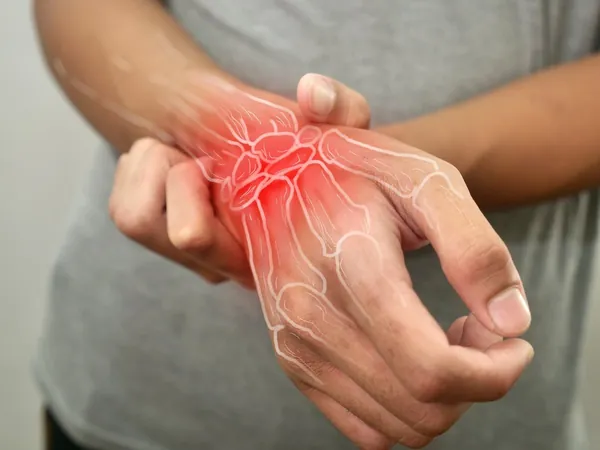
Revolutionary Nanotech Sensor Promises Rapid and Accurate Arthritis Diagnosis
2025-08-31
Author: William
Diagnosing arthritis has long presented a challenge for medical professionals, particularly when distinguishing between osteoarthritis and rheumatoid arthritis. Despite their similar symptoms—joint pain, stiffness, and swelling—the two conditions stem from vastly different origins and require unique treatment approaches. An innovative diagnostic tool is on the horizon that aims to enhance both speed and accuracy in identifying these ailments.
Meet the Game-Changer in Arthritis Diagnosis
Researchers from the Korea Institute of Materials Science (KIMS) have unveiled a state-of-the-art diagnostic platform that employs cutting-edge nanotechnology and artificial intelligence. This system can differentiate between osteoarthritis and rheumatoid arthritis in less than ten minutes, shifting away from traditional methods like X-rays and blood tests that are often lengthy, costly, and sometimes inconclusive. By focusing on joint fluid, this new method promises a quicker and more precise diagnosis.
Understanding the Distinction: Osteoarthritis vs. Rheumatoid Arthritis
Osteoarthritis (OA) affects over half of individuals aged 65 and older, occurring when the protective cartilage around bones deteriorates over time, causing pain and joint stiffness. In contrast, rheumatoid arthritis (RA) is an autoimmune disorder where the immune system mistakenly attacks healthy joints, resulting in painful inflammation, affecting approximately 1 in 100 people during their lifetime. While both conditions may appear similar at first glance, their treatment approaches drastically differ.
Groundbreaking Science Behind the Innovation
KIMS researchers, in collaboration with Seoul St. Mary’s Hospital, are harnessing synovial fluid—a sample produced by joints crucial for smooth movement—to create their diagnostic tool. They discovered significant differences in the chemical makeup of this fluid between OA and RA patients. By analyzing these metabolites, they developed a system capable of accurately determining the type of arthritis present.
Utilizing Surface-Enhanced Raman Scattering (SERS) technology, they enhance weak molecular signals emitted under laser light, amplifying them by millions of times. The sensor features a unique gold nanostructure designed to optimize molecule collection from synovial fluid and is built on a moisture-absorbing paper to effectively analyze small fluid samples.
Impressive Results and Quick Turnaround
The diagnostic platform was tested on 120 patients, achieving an impressive accuracy rate of over 94% in distinguishing between osteoarthritis and rheumatoid arthritis. Furthermore, when assessing the severity of RA, the platform reached an accuracy level exceeding 95%. In less than ten minutes, clinicians can obtain vital information, making this tool an invaluable asset in various medical settings.
Dr. Ho Sang Jung, the lead researcher, expressed optimism about the technology. "If commercialized," he stated, "this tool could revolutionize not only diagnosis but also monitoring treatment progress, offering a rapid and effective way for healthcare professionals to manage arthritis comprehensively."
Potential Beyond Arthritis
The implications of this technology extend beyond arthritis. The team believes it can be adapted to detect other diseases by analyzing different biological fluids, with their methodology readily applicable to various medical conditions.
Employing advanced statistical models like Pearson correlation and non-negative matrix factorization further refined their results, enhancing the understanding of complex biomarker patterns within joint fluid.
A New Era in Joint Health Management
This breakthrough in arthritis diagnostics could drastically reduce waiting times and improve treatment outcomes for millions suffering from joint pain. With its speed, affordability, and reliance on just a few drops of fluid, this platform represents a significant advancement in arthritis care.
As research progresses, Dr. Jung and his team aim to adapt this technology for various health conditions, potentially bringing rapid, reliable testing to hospitals worldwide and enhancing patient outcomes.
Research findings have been published online in the journal Small, signaling a promising future for both diagnosis and treatment in the realm of chronic diseases.









 Brasil (PT)
Brasil (PT)
 Canada (EN)
Canada (EN)
 Chile (ES)
Chile (ES)
 Česko (CS)
Česko (CS)
 대한민국 (KO)
대한민국 (KO)
 España (ES)
España (ES)
 France (FR)
France (FR)
 Hong Kong (EN)
Hong Kong (EN)
 Italia (IT)
Italia (IT)
 日本 (JA)
日本 (JA)
 Magyarország (HU)
Magyarország (HU)
 Norge (NO)
Norge (NO)
 Polska (PL)
Polska (PL)
 Schweiz (DE)
Schweiz (DE)
 Singapore (EN)
Singapore (EN)
 Sverige (SV)
Sverige (SV)
 Suomi (FI)
Suomi (FI)
 Türkiye (TR)
Türkiye (TR)
 الإمارات العربية المتحدة (AR)
الإمارات العربية المتحدة (AR)